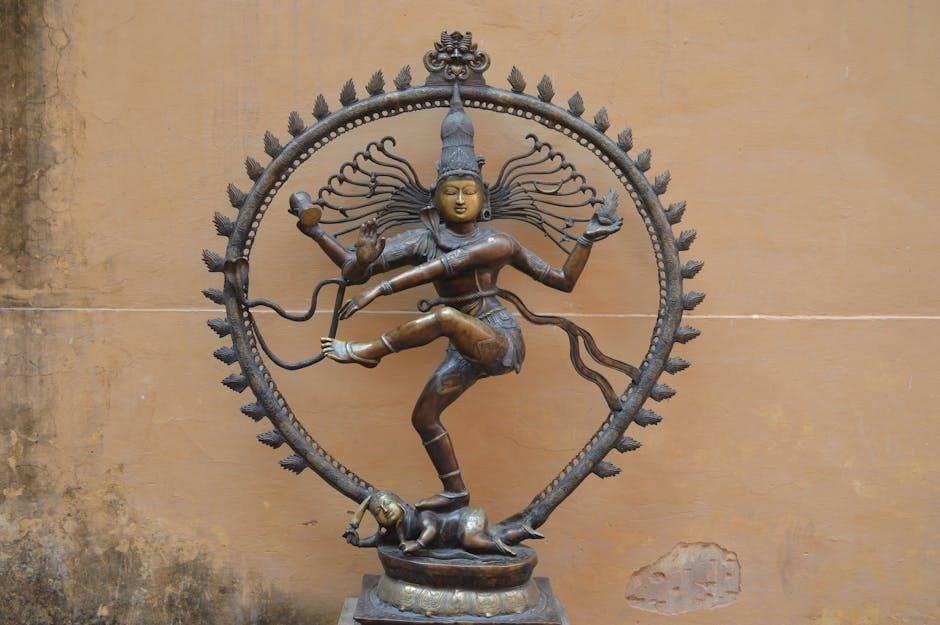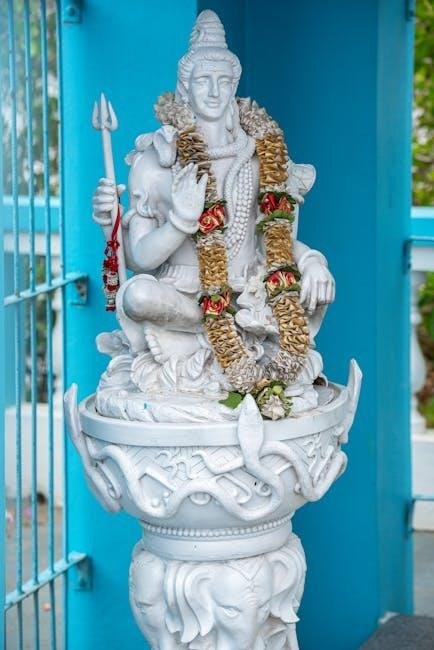Shiva Astothara Satha Namavali is a sacred Telugu prayer comprising 108 names of Lord Shiva, each embodying His divine attributes. It is a revered chant for spiritual growth and seeking His blessings, promoting inner peace and harmony.
Overview of the Significance of Shiva Astothara Satha Namavali
Shiva Astothara Satha Namavali holds immense spiritual significance as a devotional hymn dedicated to Lord Shiva, comprising 108 sacred names that extol His divine virtues. Each name embodies a unique aspect of Shiva, reflecting His cosmic role as the destroyer, transformer, and benefactor. This Namavali is widely revered in Hindu tradition, particularly in Telugu-speaking regions, where it is chanted to seek blessings, ward off negativity, and attain spiritual enlightenment. Its significance lies in its ability to connect devotees with the divine, fostering inner peace and harmony. Regular chanting is believed to grant both material and spiritual prosperity, making it a cornerstone of Shiva worship and a powerful tool for emotional and psychological well-being.
Historical Context and Origins
The Shiva Astothara Satha Namavali traces its roots to ancient Hindu scriptures, with origins in the Vedic period. This devotional hymn is a compilation of 108 sacred names of Lord Shiva, drawn from various Vedic texts and Puranas. The Namavali reflects the deep reverence for Shiva as a supreme deity, embodying His cosmic roles and attributes. Historically, it was chanted during rituals and puja ceremonies to invoke divine blessings and protection. Over time, the Namavali evolved and was adapted into regional languages like Telugu, making it accessible to a broader audience. Its historical significance lies in its ability to connect devotees with the divine, fostering spiritual growth and harmony. Today, it remains a vital part of Hindu tradition, preserved and shared through generations in various formats, including Telugu PDF versions.
Structure and Composition of the Namavali
The Shiva Astothara Satha Namavali is a structured devotional hymn consisting of 108 names of Lord Shiva, each highlighting His divine attributes and roles. The composition follows a rhythmic pattern, making it suitable for chanting and meditation. Each name is carefully selected to reflect Shiva’s cosmic significance, from His role as the destroyer of evil to His embodiment of compassion and wisdom. The Telugu version retains the original Sanskrit meanings while adapting the language for regional accessibility. The Namavali is often divided into sections for ease of recitation, with each name evoking a specific aspect of Shiva’s divine nature. This structured format ensures that devotees can connect deeply with His divine essence, fostering spiritual growth and harmony.
Significance of the 108 Names
The 108 names symbolize completeness, reflecting Shiva’s divine attributes and cosmic roles. Each name embodies His power, wisdom, and compassion, holding deep religious and cultural significance.
Religious and Spiritual Importance
Chanting Shiva Astothara Satha Namavali holds profound religious and spiritual significance, offering devotees a path to connect with Lord Shiva’s divine essence. Each of the 108 names embodies His unique attributes, such as destroyer of evil, protector, and bestower of wisdom. Reciting these names is believed to purify the mind, soul, and heart, fostering spiritual growth and inner peace. Devotees seek blessings for prosperity, happiness, and liberation from worldly bonds. The practice is also considered a powerful tool for warding off negative energies and misfortunes, emphasizing the sacred bond between the devotee and the divine. This ancient ritual remains a cornerstone of Hindu devotion, especially in Telugu-speaking regions, where it is deeply revered and practiced with utmost sincerity.
Cultural Relevance in Telugu-Speaking Regions
Shiva Astothara Satha Namavali holds immense cultural significance in Telugu-speaking regions, where it is an integral part of religious and cultural practices. The Telugu version of the Namavali is widely revered, often recited during daily pooja, temple rituals, and community events. Its availability in Telugu PDF formats has made it accessible to a broader audience, ensuring its preservation and transmission across generations. The chant is deeply embedded in the cultural fabric, reflecting the region’s rich spiritual heritage. It not only strengthens communal bonds but also influences local literature, music, and art, making it a vital component of Telugu Hindu tradition. This cultural relevance underscores its enduring popularity and the deep emotional connection it fosters among devotees.
Symbolism Behind the Number 108
The number 108 in Shiva Astothara Satha Namavali carries profound spiritual and mystical significance. It represents completeness, wholeness, and the infinite nature of existence. In Hinduism, 108 is often associated with the 108 Upanishads, the 108 beads in a mala (prayer necklace), and the 108 sacred texts of the Vedas. It symbolizes the harmony between the sun, moon, and planets, as well as the 12 zodiac signs and 9 planets in Vedic astrology. Additionally, 108 is said to represent the 108 chapters of the Rigveda and the 108 steps to enlightenment. This number is deeply rooted in tradition and reflects the cosmic order, making it a sacred choice for enumerating Shiva’s divine attributes and emphasizing His universal transcendence and eternal essence.

Benefits of Chanting Shiva Astothara Satha Namavali
Chanting Shiva Astothara Satha Namavali brings spiritual growth, inner peace, and divine blessings. It fosters emotional strength, positivity, and protection from adversities, enhancing overall well-being and prosperity.
Spiritual Benefits and Inner Peace
Chanting Shiva Astothara Satha Namavali offers profound spiritual benefits, such as heightened consciousness and a deeper connection to the divine. It fosters inner peace by calming the mind and soothing the soul, helping devotees attain mental clarity and emotional stability. Regular recitation is believed to purify the heart, dissolve ego, and cultivate humility, essential for spiritual growth. The vibrations from the chants create a sacred atmosphere, enabling devotees to transcend worldly concerns and experience divine bliss. This practice also strengthens faith and devotion, guiding individuals toward a path of self-realization and eternal peace.
Material and Emotional Benefits
Chanting Shiva Astothara Satha Namavali is believed to bring material prosperity and emotional well-being. It helps devotees overcome financial difficulties, attain stability, and achieve success in life. Emotionally, it reduces stress, anxiety, and negativity, fostering a sense of calm and balance. The recitation strengthens relationships, promoting harmony within families and communities. Many followers believe it wards off negative energies and misfortunes, creating a protective shield of positivity. Additionally, it enhances emotional resilience, empowering individuals to face life’s challenges with courage and determination. By invoking Shiva’s blessings, devotees experience a profound sense of security and fulfillment, both materially and emotionally, supported by faith and consistent practice.
Healing and Protective Aspects
Shiva Astothara Satha Namavali is deeply revered for its healing and protective qualities. Chanting these 108 names is believed to alleviate physical and mental ailments, bringing comfort and relief to the suffering. It is said to purify the body, mind, and soul, warding off negative energies and misfortunes. Devotees often recite the namavali to seek protection from adversities, believing it creates a divine shield against harm. The chants are also thought to heal emotional wounds, fostering inner peace and stability. Many trust in its power to resolve health issues and safeguard loved ones. Regular recitation is considered a potent remedy for holistic well-being and spiritual safeguarding, embodying Shiva’s grace and compassion.

How to Use Shiva Astothara Satha Namavali
Shiva Astothara Satha Namavali is used in daily worship, meditation, and special rituals. Devotees chant it during pujas, meditate on its meanings, and incorporate it into spiritual practices for divine connection and peace.
Preparation and Rituals Before Chanting
Before chanting Shiva Astothara Satha Namavali, devotees prepare through purification rituals. They bathe, wear clean clothes, and create a sacred space with offerings like flowers, fruits, and lit lamps.
The area is cleansed with incense, and a mat or sacred cloth is used for sitting. Devotees maintain a calm mind, focusing on Shiva’s divine presence.
Some perform a brief prayer seeking blessings before beginning the chant. This preparation ensures a conducive environment for spiritual connection and reverence.
Best Times and Places for Chanting
The ideal time for chanting Shiva Astothara Satha Namavali is during the early morning hours, known as Brahma Muhurta, or in the evening after sunset.
Chanting during these periods is believed to enhance spiritual focus and connection. The best places include home altars, Shiva temples, or serene natural settings like riversides or forests.
Devotees often choose locations with a peaceful ambiance to deepen their meditation and devotion; In Telugu-speaking regions, many prefer chanting in temples dedicated to Shiva, where the energy is considered sacred and conducive to worship.
Mantra Pronunciation and Accuracy
Accurate pronunciation of the Shiva Astothara Satha Namavali is crucial for its spiritual efficacy. Mantra pronunciation must adhere to traditional guidelines to preserve their sacred energy.
Even slight errors in intonation or rhythm can alter the mantra’s meaning or effectiveness. Devotees are advised to learn from qualified scholars or reliable resources to ensure accuracy.
The Telugu version, being phonetic, retains the original Sanskrit sounds, making it easier for speakers to maintain authenticity. Regular practice and mindfulness during chanting help in mastering the pronunciation, fostering a deeper connection with the divine. This attention to detail is vital for reaping the full spiritual benefits of the namavali.

Shiva Astothara Satha Namavali in Telugu
Shiva Astothara Satha Namavali in Telugu is a sacred prayer featuring 108 divine names of Lord Shiva, reflecting His attributes and significance in Hindu spirituality and culture. Available as a downloadable PDF, it provides devotees with an accessible tool for worship and meditation, preserving the essence of devotion in the Telugu language.
Language and Transliteration
The Shiva Astothara Satha Namavali in Telugu is written in the Telugu script, which holds great cultural and religious significance. For those unfamiliar with the script, transliterated versions in Romanized English are available, ensuring accessibility. The Telugu language preserves the sacredness of the hymn, while transliteration aids non-Telugu speakers in accurate pronunciation and devotion. This dual approach maintains the prayer’s authenticity and expands its reach globally, fostering unity among devotees regardless of linguistic barriers. The careful transliteration ensures that the spiritual essence and meaning of each name remain intact, making it a valuable resource for both traditional and modern worshippers.
Availability of Telugu PDF Versions
Telugu PDF versions of Shiva Astothara Satha Namavali are widely available online, catering to devotees seeking digital access. Popular platforms like Hithokthi Telugu and other spiritual websites host these documents, ensuring easy downloading. Many temples and cultural organizations also provide free PDF downloads, often accompanied by transliterated versions for non-Telugu speakers. These PDFs are designed for convenient reading, with clear formatting and searchable features. Additionally, mobile apps dedicated to Hindu scriptures offer downloadable versions, making it accessible on-the-go. The availability of these resources has significantly increased, reflecting the growing demand for digital spiritual content. This ensures that the sacred hymn remains accessible to a global audience while preserving its cultural and religious significance.

Key Differences from Sanskrit Versions
The Telugu PDF versions of Shiva Astothara Satha Namavali differ from Sanskrit versions primarily in language and script; Telugu texts use the Telugu alphabet, making them accessible to Telugu-speaking devotees, while Sanskrit versions are in Devanagari. The structure remains similar, but transliterations may vary slightly to accommodate phonetic differences. Additionally, Telugu versions often include localized interpretations or commentaries, reflecting regional cultural nuances. Some names may be adapted to resonate more deeply with Telugu traditions, though the spiritual essence remains unchanged. These adaptations ensure the hymn’s relevance while preserving its sacred intent, making it a bridge between ancient traditions and modern accessibility for Telugu speakers worldwide.

DOWNLOAD And Access
The Shiva Astothara Satha Namavali in Telugu PDF is widely available online. It can be downloaded from trusted spiritual websites, temples, or platforms like Hithokthi Telugu, ensuring safe access to this sacred text for devotees.
Where to Find the PDF Online
The Shiva Astothara Satha Namavali in Telugu PDF can be easily found on various spiritual and religious websites. Popular platforms like Hithokthi Telugu and other devotionalsites host this sacred text. Additionally, it is available on YouTube channels dedicated to Hindu prayers and mantra chants. Many temple websites also offer free downloads of the Namavali for devotees. Some spiritual apps and e-book platforms provide easy access to the PDF. When searching, use keywords like “Shiva Astothara Satha Namavali Telugu PDF download” to find reliable sources. Ensure to verify the authenticity of the content before downloading, as multiple versions may exist. This sacred text is widely accessible, making it convenient for devotees to obtain and use for their daily worship.

How to Download the PDF Safely
To safely download the Shiva Astothara Satha Namavali in Telugu PDF, choose reputable websites with secure connections (HTTPS). Look for trusted sources like temple websites or well-known spiritual platforms. Avoid unofficial or suspicious links to prevent malware. Before downloading, ensure the PDF is from a verified source by checking reviews or descriptions. Scan the file with antivirus software to confirm it’s safe. Verify the PDF’s authenticity by ensuring it aligns with traditional content and formatting. Be cautious of pop-up ads or redirects, as they may lead to harmful downloads. Always prioritize reliable platforms to avoid scams or viruses. Downloading from trusted sources ensures a secure and spiritual experience.
Recommended Apps and Platforms
Accessing the Shiva Astothara Satha Namavali in Telugu PDF is made convenient through various trusted apps and platforms. Apps like Hithokthi Telugu offer authentic spiritual content, including this namavali. Platforms such as Vedic Vault and Spiritual Books provide downloadable PDFs for free or at minimal cost. Additionally, temple websites and apps dedicated to Hindu scriptures often host this document. For a seamless experience, consider using Hindu Temple Apps or Bhakti Apps, which offer both PDF downloads and audio recitations. Always ensure you download from verified sources to avoid unauthorized content. These platforms are user-friendly and cater to devotees seeking spiritual resources, making them ideal for accessing and preserving this sacred text.

Understanding the Names
Each name in Shiva Astothara Satha Namavali reflects a unique attribute of Lord Shiva, such as destroyer, protector, and benefactor. Together, they reveal His divine essence and significance.
Meaning and Interpretation of Each Name
Each name in the Shiva Astothara Satha Namavali holds profound spiritual significance, reflecting Lord Shiva’s divine attributes. These names, such as “Shiva” (the auspicious one) and “Mahadeva” (the great god), highlight His role as both destroyer and protector. The namavali intricately weaves together His cosmic duties, cultural relevance, and philosophical essence. Every name is a meditation on His transcendental nature, embodying qualities like compassion, wisdom, and eternal existence. The interpretations are deeply rooted in Hindu scriptures and philosophical thought, offering devotees a pathway to connect with the divine. This sacred recitation is not just a ritual but a journey into the depths of Shiva’s cosmic presence and universal harmony.
Relevance of Each Name to Shiva’s Attributes
Each name in the Shiva Astothara Satha Namavali is intricately linked to Shiva’s divine attributes, showcasing His multifaceted nature. Names like “Shiva” and “Mahadeva” emphasize His role as the auspicious and supreme deity. Others, such as “Shambhu” and “Sankara,” highlight His benevolent and gracious aspects. The namavali also underscores Shiva’s cosmic roles, like “Vishveshwara” (lord of the universe) and “Pashupati” (lord of all beings), reflecting His omnipotence. The names further symbolize His destructive and transformative powers, as seen in “Rudra” and “Hara.” Each name serves as a devotionally charged descriptor, connecting worshippers to Shiva’s infinite qualities. The namavali thus becomes a comprehensive celebration of His divine essence and universal presence.
Common Misconceptions About the Names
Some believe the names in Shiva Astothara Satha Namavali are too complex for laypersons, but they are accessible to all devotees. Another misconception is that the names are only for specific rituals, while they are meant for daily worship. People often think the names are repetitive, yet each carries unique spiritual significance. There’s also a belief that the names must be chanted perfectly to be effective, though sincerity matters more than pronunciation. Additionally, some assume the namavali is only for spiritual growth, ignoring its role in seeking material blessings. These misunderstandings limit the namavali’s universal appeal and practical applications.

Practical Applications
Shiva Astothara Satha Namavali is used in daily pooja, meditation, and rituals for spiritual growth and material blessings. It is also taught to others for spreading devotion and harmony.
Using the Namavali in Daily Pooja
Shiva Astothara Satha Namavali is integral to daily pooja rituals, offering devotees a structured way to connect with Lord Shiva. Chanting the 108 names during pooja helps create a serene atmosphere, fostering spiritual growth and divine blessings. Many Telugu-speaking devotees incorporate this namavali into their morning and evening prayers, believing it enhances the effectiveness of their worship. The recitation is often accompanied by offerings like flowers, water, and lamps, symbolizing devotion and surrender. Regular chanting is said to bring balance, prosperity, and inner peace, making it a cherished practice in many Hindu households. Its inclusion in daily rituals strengthens faith and deepens the bond with the divine.
Integrating the Namavali into Meditation
Integrating Shiva Astothara Satha Namavali into meditation enhances spiritual focus and inner tranquility. Devotees often recite the 108 names of Lord Shiva during meditation to align with His divine energy. The rhythmic chanting creates a calming atmosphere, helping the mind concentrate and achieve mental clarity. Each name, rich with meaning, serves as a mantra, fostering a deeper connection with the divine; Many meditators begin by setting a sacred intention, then recite the names slowly, reflecting on their significance. This practice is believed to purify the soul, bring inner peace, and strengthen spiritual growth. The Telugu PDF versions of the namavali are particularly useful, as they provide accurate pronunciation and meaning, making the meditation experience more authentic and fulfilling.
Teaching the Namavali to Others
Teaching Shiva Astothara Satha Namavali to others is a noble act that strengthens one’s own spiritual connection and fosters devotion in the community. Sharing this sacred text with others enhances understanding and appreciation of Lord Shiva’s divine attributes. Many devotees use the Telugu PDF version to guide learners, ensuring accurate pronunciation and meaning. Teaching the namavali not only spreads spiritual knowledge but also deepens the teacher’s own practice. It fosters emotional and spiritual bonding among participants, creating a shared sense of purpose. By passing on this tradition, one contributes to its preservation and ensures its relevance for future generations, keeping the legacy of Shiva’s worship alive and vibrant.

Cultural Impact
Shiva Astothara Satha Namavali holds profound cultural significance in Telugu-speaking regions, being a cornerstone of Hindu tradition and a source of inspiration in literature, music, and art.
Role in Telugu Hindu Tradition
Shiva Astothara Satha Namavali is deeply embedded in Telugu Hindu tradition, serving as a cornerstone of devotion. It is recited during daily pujas, festivals, and special ceremonies, fostering spiritual connection. The Namavali is often chanted in temples and homes, symbolizing reverence for Lord Shiva. Its influence extends beyond worship, inspiring Telugu literature and music, with many compositions drawing from its verses. The prayer is a unifying force, strengthening community bonds and preserving cultural heritage. It is a vital part of Telugu identity, reflecting the region’s rich spiritual and artistic legacy. The Namavali’s rhythmic recitation creates a meditative atmosphere, deepening devotion and emotional connection to the divine.
Use in Temples and Community Events
The Shiva Astothara Satha Namavali is prominently featured in temple rituals and community events across Telugu-speaking regions. During Maha Shivaratri and other significant festivals, priests and devotees chant the Namavali collectively, creating a sacred ambiance. Community gatherings, such as marriage ceremonies and cultural fairs, often incorporate this prayer to invoke blessings. Temples distribute the Telugu PDF versions, ensuring accessibility for all participants. The synchronized recitation fosters unity and spiritual harmony among devotees. This practice strengthens communal bonds and reinforces the cultural significance of the Namavali, making it an integral part of collective worship and celebration. Its widespread use in temples and events underscores its enduring relevance in Telugu Hindu tradition.
Influence on Telugu Literature and Music
Shiva Astothara Satha Namavali has profoundly influenced Telugu literature and music, inspiring devotional compositions and poetic works. Its rhythmic structure and profound meanings have been incorporated into traditional hymns and songs, enriching cultural heritage. Telugu poets often draw inspiration from the Namavali, weaving its spiritual essence into their verses. In music, the Namavali is set to melodious tunes, creating soul-stirring devotional songs that resonate with devotees. Its verses are frequently used in harikathas and bhajans, further popularizing its message. The Namavali’s influence extends to modern adaptations, with digital platforms featuring audio renditions and apps dedicated to its recitation. This timeless text continues to inspire artistic expression, bridging tradition and contemporary culture.
Modern Relevance
Shiva Astothara Satha Namavali remains highly relevant today, with digital platforms and apps making it accessible to a younger generation. Its timeless spiritual essence continues to inspire devotion and peace in modern life.
Adaptation in the Digital Age
In the digital age, Shiva Astothara Satha Namavali has evolved to reach a wider audience. PDF versions of the Namavali in Telugu are now readily available online, making it accessible to devotees worldwide. Spiritual apps and websites offer downloadable resources, enabling easy access to the sacred text. This digital transformation has simplified the process of chanting and meditating on the 108 names, allowing devotees to practice their faith conveniently. The shift to digital platforms has also helped in preserving the tradition while catering to the needs of modern worshippers. This adaptation ensures the timeless spiritual significance of Shiva Astothara Satha Namavali remains relevant in contemporary times.
Popularity Among Younger Generations
The Shiva Astothara Satha Namavali in Telugu PDF has gained significant popularity among younger generations due to its digital accessibility. With the rise of spiritual apps and online platforms, young devotees can easily download and chant the Namavali, making it a convenient way to connect with their cultural and religious heritage. The availability of PDF versions in Telugu has bridged the gap between traditional practices and modern technology, appealing to tech-savvy youth; Additionally, social media and online communities have played a role in spreading its relevance, encouraging younger people to embrace this ancient devotion as a means of spiritual growth and personal well-being in today’s fast-paced world.
Contemporary Interpretations and Usage
In contemporary times, the Shiva Astothara Satha Namavali in Telugu PDF is being embraced as a versatile spiritual tool. Many modern practitioners integrate it into yoga and meditation routines, blending traditional devotion with holistic well-being practices. Younger generations often interpret the names as metaphors for personal growth and self-realization, while others use them in creative expressions like music and art. Digital platforms have made it easier to access and share, fostering a global community of devotees. This ancient hymn continues to evolve, adapting to modern lifestyles while retaining its core spiritual essence, making it a meaningful practice for both traditionalists and modern seekers alike.